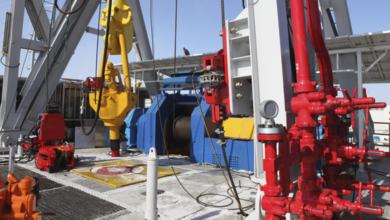‘It’s all about working together and communicating’
Rustom Mody, Baker Hughes
By Linda Hsieh, assistant managing editor
It should come as no surprise that Baker Hughes’ Rustom Mody is passionate about researching and developing high-tech solutions to the industry’s myriad completion and production problems. After all, he is the company’s vice president of technology for completions and production.
But it might be more surprising to note that – as much as he loves working with technology – it’s the people element of this industry that truly gets him energized. He believes that finding solutions to technical problems ultimately lies in

people. Whether it’s developing young engineers, providing an environment that cultivates research and innovation, or encouraging employees from different product lines to share knowledge – his job is all about finding ways for people to communicate and work together.
Take, for example, Mr Mody’s efforts to get his company involved in a technology exhibition where different product lines could share ideas and understand what technologies other colleagues are working on. “There’s so much technology development going on within Baker Hughes, we thought, why don’t we start a technology forum so that all the engineers and designers can get together and exchange technologies and share ideas?”
So Mr Mody and his colleagues did just that, intent on breaking down the walls between engineering groups and encouraging a cross-pollination of ideas. In just a few years, the forum has evolved into an annual event for Baker Hughes, with participation by nearly 1,000 people and approximately 150 technical papers presented every year. “There are no outside people allowed so everyone can openly discuss everything they’re working on. Everything’s on the cutting edge. … It really comes down to talking, communicating, networking and working together as one Baker Hughes. It is a perfect venue for young engineers to get exposed to new technologies and feel proud to be part of Baker Hughes,” he said.
The Center for Technology Innovation (CTI), which opened in Houston in 2008, has been another milestone. Not only does it bring together numerous engineering groups to one location to facilitate the sharing of ideas, the CTI was also set up as a haven for research, utilizing capabilities to simulate HPHT (700°F, 40,000 psi) downhole environments and various research labs. Here, there are no distractions from the day-to-day work of product manufacturing or engineering support. Rather, everyone is focused on innovative strategic development. “We’re talking long-term stuff, from nanotechnology to shape memory polymers to high-temperature elastomers and electronics to composites,” he said.
That the company was willing to invest in such a tremendous facility is something Mr Mody is proud of. “Especially in a downturn, research is not a luxury, it’s a necessity. In the past, the tendency has always been to cut back on research during downturns. However, by staying focused on R&D as a long-term strategy for when the market recovers, you will find yourself well-equipped with the right technology when needed.
“Research is not something you can turn on and off overnight,” he continued. “It takes years to establish an organizational momentum with the skilled personnel to deliver advanced technologies. I really want us to have a long-term vision of what we want to be as an organization and have the discipline to be proactive in developing cutting-edge technology.”
Problems and solutions
Outside of his company, the people element is critical as well. As VP of technology responsible for the company’s completions and production segments, Mr Mody spends a significant portion of his time participating in industry technology forums and talking with leaders at oil companies. His goal: to find out what’s keeping them awake at night. Because you can’t solve a problem if you don’t know what the problem is. “90% is defining the problem. 10% is developing a solution. Once you know what the problem is, you can find a way to solve it.”
To that end, Baker Hughes is pushing technologies that could be breakthroughs in areas like sand control and wellbore monitoring, Mr Mody said. “We’re trying to focus on major technologies and bring them to the market in the near term. We are collaborating with major clients early on so they can have input in the development.”
He added that adoption of new technologies within the industry is still too slow, taking up to 12 to 15 years before 50% of the industry will embrace it. Part of the solution could lie in joint technology development projects with operators – a trend that appears to be growing. “Operators know what their needs are, and they want to be part of technology development,” he said. “The responsibility lies within all of us to advance technology going forward.”




'It's all about working together and communicating' | Drakz Free Online Service